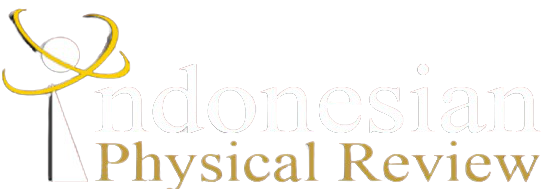TWO-PARTICLE THERMAL DENSITY MATRICES IN ONE DIMENSION USING FINITE DIFFERENCE TIME DOMAIN (FDTD) METHOD
DOI:
10.29303/ipr.v1i1.13Downloads
Abstract
A quantum system in the thermal equilibrium state is a mixed state consisting of statistical ensembles of several different quantum systems can be represented by a thermal density matrix. In this research, the thermal density matrix is calculated for two-particle system case non-interaction in one-dimensional square well and one-dimensional harmonic oscillator using finite difference time domain (FDTD) method. In addition, thermal density matrix calculations are also performed for the case of two particle systems interacting in a one-dimensional harmonic oscillator. We present results of probability densities, partition functions, and internal energies for three cases: two distinguishable particles, two fermions and two bosons. Validation of numerical results of thermal density matrix and probability density is accurate with analytical solutions. Then, the result of partition function and internal energy the system is strongly effect by temperature. At low temperatures, internal energy the system will lead to the lowest energy or ground state.References
Feynmann R P. 1972. Statistical Mechanics. Reading, MA : Benjamin.
Greiner W, dkk. 1995. Thermodynamics and Statistical Mechanics. New York : Springer.
Karl Blum. 2012. Density Matrix Theory and Applications 3rd Edition. Germany : Springer-Verlag Berlin Heidelberg.
Landau L. D. and Lifshitz E. M. 1958. Statistical Physics. London-Paris: Pergamon Press.
Journal articles:
Bransden B. H. dan Charles J. J. 1989. Introduction to quantum mechanics. Longman Scientific & Technical.
Borrmann P. 1994. Path Integral Density Functional Theory. Oldenburg: Carl von Ossietzky Universit at Oldenburg.
D Ter Haar. 1961. Theory and Applications of the Density Matrix. Oxport : The Clarendon Laboratory. Online at http://iopscience.iop.org/0034-4885/24/1/307.
Fano U. 1957. Description of States in Quantum Mechanics by Density Matrix and Operator Techniques. Washington : National Bureau of Standards. Volume 29, Number 1.
Feynmann R P. 1972. Statistical Mechanics. Reading, MA : Benjamin.
Greiner W, dkk. 1995. Thermodynamics and Statistical Mechanics. New York : Springer.
Karl Blum. 2012. Density Matrix Theory and Applications 3rd Edition. Germany : Springer-Verlag Berlin Heidelberg.
Klem A. D. dan Storer R. G. 1973. The Structure of Quantum Fluids: Helium and Neon. Geelong : Mathematics Department, Gordon Institute of Technology. .Aust. J. Phys., 1973, 26, 43-59.
Kunz, K. S., & Luebbers, R. J. 1993. The Finite Difference Time Domain Method for Electromagneticcs. Boca Raton: CRC press.
Landau L. D. and Lifshitz E. M. 1958. Statistical Physics. London-Paris: Pergamon Press.
March N H, dkk. 1967. The Many-Body Problem in Quantum Mechanics. New York : Dover.
Malone F. D, dkk. 2015. Interaction Picture Density Matrix Quantum Monte Carlo. London: Imperial College London. The Journal of Chemical Physics 143, 044116 (2015).
McWeeny R. 1960. Some Recent Advances in Density Matrix Theory. Keele : Unverstiy College of North Staffordshire. Volume 32, Number 2.
Neumann J V. 1955. Mathematical Foundations of Quantum Mechanics. Princeton : Princeton University Press.
Novac I. 2001. Two Particles in a Box. Singapure : National University of Singapure.
Storer R G. 1968. Path-integral Calculation of The Quantum Statistical Density Matrix for Attractive Coulomb Forces. J. Math. Phys. 9 964.
Sudiarta I W and Geldart D J W. 2007. Solving the Schr¨odinger Equation using The Finite Difference Time Domain Method. J. Phys. A: Math. Theor. 40 1885 http://doi:10.1088/1751–8113/40/8/013.
Sudiarta I W and Geldart D J. 2009. The Finite Difference Time Domain Method for Computing the Single-Particle Density Matrix. J. Phys. A: Math. Theor. 42 (2009) 285002 (20pp). http://doi:10.1088/1751-8113/42/28/285002.
License
Copyright (c) 2018 Indonesian Physical Review

This work is licensed under a Creative Commons Attribution-NonCommercial-ShareAlike 4.0 International License.
Authors who publish with Indonesian Physical Review Journal, agree to the following terms:
- Authors retain copyright and grant the journal right of first publication with the work simultaneously licensed under a Creative Commons Attribution-ShareAlike 4.0 International Licence (CC BY SA-4.0). This license allows authors to use all articles, data sets, graphics, and appendices in data mining applications, search engines, web sites, blogs, and other platforms by providing an appropriate reference. The journal allows the author(s) to hold the copyright without restrictions and will retain publishing rights without restrictions.
- Authors are able to enter into separate, additional contractual arrangements for the non-exclusive distribution of the journal's published version of the work (e.g., post it to an institutional repository or publish it in a book), with an acknowledgment of its initial publication in Indonesian Physical Review Journal.
- Authors are permitted and encouraged to post their work online (e.g., in institutional repositories or on their website) prior to and during the submission process, as it can lead to productive exchanges, as well as earlier and greater citation of published work (See The Effect of Open Access).





